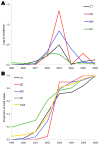Ecological factors associated with West Nile virus transmission, northeastern United States
- PMID: 18826816
- PMCID: PMC2609885
- DOI: 10.3201/eid1410.071396
Ecological factors associated with West Nile virus transmission, northeastern United States
Abstract
Since 1999, West Nile virus (WNV) disease has affected the northeastern United States. To describe the spatial epidemiology and identify risk factors for disease incidence, we analyzed 8 years (1999-2006) of county-based human WNV disease surveillance data. Among the 56.6 million residents in 8 northeastern states sharing primary enzootic vectors, we found 977 cases. We controlled for population density and potential bias from surveillance and spatial proximity. Analyses demonstrated significant spatial spreading from 1999 through 2004 (p<0.01, r2 = 0.16). A significant trend was apparent among increasingly urban counties; county quartiles with the least (<38%) forest cover had 4.4-fold greater odds (95% confidence interval [CI] 1.4-13.2, p = 0.01) of having above-median disease incidence (>0.75 cases/100,000 residents) than counties with the most (>70%) forest cover. These results quantify urbanization as a risk factor for WNV disease incidence and are consistent with knowledge of vector species in this area.
Figures



References
Publication types
MeSH terms
LinkOut - more resources
Full Text Sources
Medical
